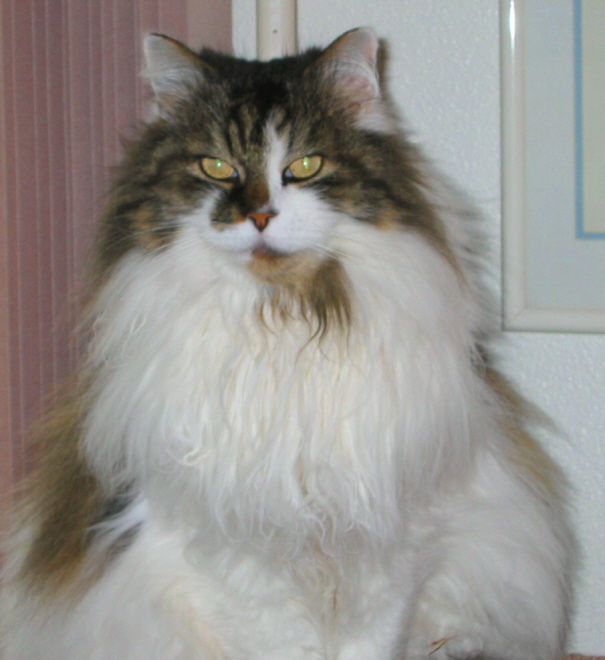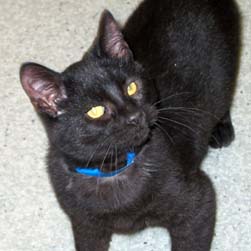Alvin Elvis Smith
In June of 1993, I found myself without a cat and decided to remedy the situation. I decided on females and no long-haired cats. Then I met an eight-week-old half-Persian and all the rules went out the window. Alvin was my loving companion for the next 18 years. While I was working, his job was alarm cat. If I didn’t get up when the alarm sounded, he would jump up on the headboard just out of reach and chirp “Get up, get up” until I gave in and got up. He loved his food bowl above all else except me. He followed me about like a dog, finding a place to curl up nearby wherever I happened to be. He tolerated the other two cats he lived with over the years, as he tolerated the regular trips to the groomer.

He will remain in my heart forever.
Lenny’s Story
It was a September day when “one more litter” arrived at the Shelter. They were typical – five rambunctious 12 week old black or black and white kittens. After a week or so, two were adopted, and in another week or so, one more went home. That left Sandi (black and white) and Lenny (solid black and the runt of the litter). Since they were getting old enough for their opposite sexes to be a problem, Lenny was moved in with Theo, another solid black male, and Sandi got a cage of her own.

Time went by and before we knew it they were 5 months old and ready to be altered. Theo was adopted and we moved Sandi and Lenny to the front catteries. More time went by, cats came and went and still no homes for Sandi and Lenny. When the West Coast Bank offered to have us bring adoptable animals over, Sandi and Lenny were among the first group of cats we took, and the magic worked for Sandi! She was adopted that day!
Poor Lenny went back to the Shelter to wait some more. Two months later we took him to the bank again – no luck again, even though he thoroughly charmed everyone with his sweet disposition and adorable squeak. By now Lenny was almost 7 months old and was setting records for the most roommates ever. He became known as “the diplomat” because he was willing to share quarters with any other cat, even if it was a bit cranky.
Just when we had almost given up, I got a call – “Guess who got adopted today?!” Yes, Lenny finally found his forever home, and Poquito went with him. They’d just met that day, but Lenny said, “Sure, he’s fine with me.” Ah, diplomacy.
A Feral Cat Story
My name is Pam and my husband is Jerry. This is our story.
After 12 years of living in the little coastal town of Waldport, OR, we moved to southern Oregon. Making the move with us were our seven pet cats and one disabled raccoon that had been living on our property in Waldport. With a proper Wildlife Permit and a humane live trap, we were able to transport this little guy to his new home at Wild Life Images Refuge. We just couldn’t leave him behind.
Once in southern Oregon, we stayed with family while looking for that perfect acreage on which to build our retirement home. We found that perfect 5 acres and began preparing the land for building the dream home for us and our kitties. One day, my sister took me to view the work being completed on a house for a bank. The previous owner had become disabled quite suddenly and had abandoned his property – which included 21 cats, none spayed or neutered! When I saw the cats, they all looked hungry, thirsty, and frightened, scattering all over the yard.
Going door to door, I checked with all the neighbors and learned how angry and upset they were over the “cat” problem. No one knew what to do. So I decided to do some research, not realizing I would be in this new learning curve alone with only one supporter – Jerry. He is a compassionate person, but even he looked at my sad eyes and said, “Please don’t do this. We don’t even have a home for ourselves yet.”
The local veterinarians suggested dry cat food, so we loaded up our trunk with as many bags as it would hold, along with jugs of fresh water and feeding bowls. We also called the local animal shelter, the humane society, and CATS (Committed Alliance to Strays). Were the cats friendly and adoptable was the question we were asked most often. The answer was simple, “No, they are scared and have been chased and yelled at by every person in the neighborhood. Friendly will not fit on their list right now.” It was suggested we feed them for a month and see if we could tame some if not all. We can do that, we thought! Little did we know; so began the adventure into new knowledge. During that month, the cats were always glad to see us. They were not approachable. They waited until the food was replenished and the water fresh, then once we were at a safe distance standing by the car, they came and ate with one eye on us at all times. A quick movement and they scattered. Then out from under the carport storage area came two kittens. Oh, no! We now had kittens.
After the month, we checked back with all the animal resources and apprised them of our progress. The consensus was…these were feral cats. It was explained to us that they are cats not socialized to interacting with human beings. Chances are they would never change. It was suggested that we bring them in and have them euthanized.
This was totally unacceptable! “They all have names, personalities, and feel emotions,” we said. “We could never do that to them. They show affection and communicate with one another, looking out for each member of the group.” We had observed a big black male cat gently nudging the two kittens to keep them safely in the yard as the mother cat enjoyed her meal in peace. We felt abandoned ourselves. And very lonely.
Then Bev Eaton, a board member of CATS, came into our lives. She and a vet technician made a follow-up phone call and asked if the ferals had been euthanized yet. Our answer? No, not happening, EVER. She then asked if we had a plan. Did we?
Bev Eaton of CATS (Committed Alliance to Strays) had just contacted us about the ferals we had discovered and wanted to know if we had a plan since euthanizing was absolutely out of the question.
We explained that our hope was to have enough time to build a 10’ x 12’ mini-barn on our new property with the same size roofed kennel attached with a kitty door. Our future plan was to keep them contained until after our home was built. When our property was calm and quiet, we would let them out during the day and bring them inside the mini-barn around 4:30 pm with the treat of canned cat food.
Bev offered a temporary solution – providing an immediate safe haven in a heated room off her garage, about 45 minutes away. We trapped the cats, taking a few days to get all 21, and transported them to her heated garage. Then we had to do the trapping all over again in order to get the cats to the vet for medical testing, spaying/neutering, ear tipping, and whatever else was needed. It took the support and dedication of all of us to accomplish this with 21 feral cats. Bev even guided us to the humane society for the spay/neuter coupons that greatly cut the cost of the surgeries. The local vets were also very supportive in that they allowed us to bring in the cats anytime without an appointment. Several friends donated money to help defray the costs of the additional medical procedures and tests. All the cats healed perfectly without any complications.
When it was time to transfer this group to our new property, 7 of the ferals did escape; however, they joined Bev’s colony and continue to thrive. Three more decided they wanted to live with our neighbors and were welcomed with love and caring. The neighbors now know how fun and special feral cats can be.

Two of the ferals have passed away from natural causes and their resting places are in a special area of our front yard right next to our deceased indoor kitties that have passed on. Our feral kitties are loved, remembered, admired, and treasured for their extraordinary lives. They are grieved and missed exactly the same as our socialized kitties – never forgotten, loved forever. Nine are still with us – all with names and 7 of those come to us for backrubs and sweet talk. The latest recently looked into our eyes as if to say, “You can pet me now, you have proved yourselves.”
Today our feral cats have 24-hour access in their mini-barn to their water and Prescription CD dry cat food. They are very funny about waking up in the morning – 11 a.m. is their favorite time to come out and play. At 4:30 pm every day, they are waiting on the deck for one of us to come out with the canned food. There is never a problem getting them to go in for the night. They have a knowing that they are safe in their nest at night, protected from predators. The cats love their structures. They are very smart and work with us. We believe they instinctively knew we had their best interests at heart.
We feel like the luckiest Pied Piper ever as these cats trit-trot all around us, going across the yard to their kennel/barn. We always feel so uplifted by their enthusiasm and spirit. In a heartbeat, we would tell anyone who asked that we would do this all over again. We are a middle-class couple with a middle-class income, but we have never been sorry about helping all these ferals. I tell Jerry that one of these days we should make an educational video sharing with people that feral cats are actually easier than house kitties. We are so happy that they found US!
Submitted by Pam and Jerry Gersich of Jacksonville, OR
